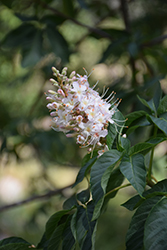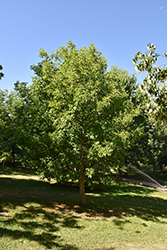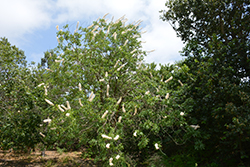Fri & Sat 8am - 8pm
Sun 8am - 7pm
Anytown, USA 12345
fax: 261.787.0463
e-mail: info@successgc.com


Plant Finder

Height: 30 feet
Spread: 30 feet
Sunlight:
![]()
![]()
Hardiness Zone: 7a
Description:
An attractive California native large shrub or small tree that features erect panicles of fragrant, creamy white to pink flowers in spring, over shiny, palmate, dark green leaves; fall capsules produce brown nuts; summer dormant in dry conditions
Ornamental Features
California Buckeye features showy spikes of fragrant white spider-like flowers with shell pink overtones and orange anthers rising above the foliage from early to mid spring. The flowers are excellent for cutting. It has attractive dark green foliage with grayish green undersides and tinges of bluish-green. The glossy palmate leaves are highly ornamental and turn coppery-bronze in fall. It produces brown capsules from late summer to late fall. The fruit can be messy if allowed to drop on the lawn or walkways, and may require occasional clean-up.
Landscape Attributes
California Buckeye is a multi-stemmed deciduous tree with a more or less rounded form. Its average texture blends into the landscape, but can be balanced by one or two finer or coarser trees or shrubs for an effective composition.
This is a high maintenance tree that will require regular care and upkeep, and should only be pruned after flowering to avoid removing any of the current season's flowers. It is a good choice for attracting butterflies and squirrels to your yard, but is not particularly attractive to deer who tend to leave it alone in favor of tastier treats. Gardeners should be aware of the following characteristic(s) that may warrant special consideration;
- Insects
- Disease
California Buckeye is recommended for the following landscape applications;
- Accent
- Shade
- Hedges/Screening
- Naturalizing And Woodland Gardens
Planting & Growing
California Buckeye will grow to be about 30 feet tall at maturity, with a spread of 30 feet. It has a low canopy with a typical clearance of 2 feet from the ground, and is suitable for planting under power lines. It grows at a medium rate, and under ideal conditions can be expected to live to a ripe old age of 250 years or more; think of this as a heritage tree for future generations! As this plant tends to go dormant in summer, it is best interplanted with late-season bloomers to hide the dying foliage.
This tree does best in full sun to partial shade. It prefers to grow in average to dry locations, and dislikes excessive moisture. It is considered to be drought-tolerant, and thus makes an ideal choice for xeriscaping or the moisture-conserving landscape. This plant should not require much in the way of fertilizing once established, although it may appreciate a shot of general-purpose fertilizer from time to time early in the growing season. It is not particular as to soil type or pH. It is somewhat tolerant of urban pollution. Consider applying a thick mulch around the root zone in winter to protect it in exposed locations or colder microclimates. This species is native to parts of North America, and parts of it are known to be toxic to humans and animals, so care should be exercised in planting it around children and pets.


